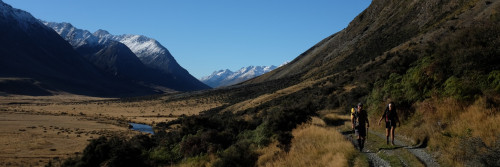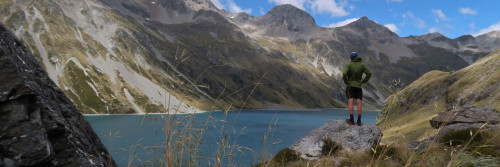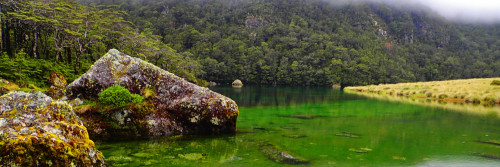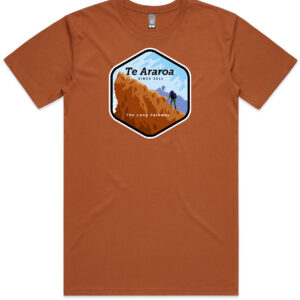News and media
The Motatapu track

As I climbed towards Roses Saddle, the weight of my pack seemed to increase and that bottle of wine buried deep inside became, instead of proud evidence of my packhorse capacity, a symbol of stupid excess.
Back at the campground, it had seemed to me the Motatapu Track needed some sort of boisterous christening. This was the track that Shania Twain, and her husband Mutt Lange had gifted to the nation. They'd agreed to a legal easement across 29 kilometres of their land. They'd paid for the huts en route. Various holdups had occurred, but now it was open - an essential link between Wanaka and Arrowtown for the longer Te Araroa track that is to run north-south the length of the country. Wine also seemed proper because this was a three-day tramp and the third day in was my birthday.
Our party of nine hired a Nomad Safari 4WD in Queenstown to take us up to historic Macetown, the old goldmining settlement. We arrived at 3.30 pm, admired the brand new DoC sign with its Te Araroa logo, and set off up north alongside the Arrow River, before beginning the 500-metre climb to Roses Saddle. We were climbing to over 1200 metres, at about the same 1.5 kph speed that the pack bullocks used to traverse this same trail, and away to the south I could see the jagged tops of the Remarkables Range and closer to hand, shadows deepening on the smooth and powerful Otago high country hills.
The views got lovelier, but the ridge got steeper, and the pack got heavier. Even on the first day, we northerners were calling this a hard track. As we followed the DoC orange-topped warratahs we often took different routes to the next pole, pushing through matagouri, or hauling ourselves upwards on handholds of tussock. I caught up with Bruce Palmer.
"It's Shania and Mutt's track Bruce, so let's say I don't doubt that this trail is music but maybe its more Indie Rock than Country. It's demanding. It's a little rough in places . . ."
"And like Indie Rock," said Bruce, "inaccessible to some."
It wasn't the kind of terrain where you lugged any more weight than you had to, and when I got to the hut after nightfall, I broke out the wine right away. Birthday or not, I wasn't going to carry it a step further.
Bruce dug into his pack, and immediately matched it with a bottle of pinot gris. Party time. We toasted the birthday that through force of circumstance had come two days early. We toasted the beautiful 10-bunk hut. We toasted the new track. Six of the nine people gathered in that hut, including Fiona Mackenzie who'd joined the tramp after completing the annual Motatapu Icebreaker 08 - the 50km mountain bike race through the nearby Motatapu Valley, and Michael Pullar our South Island man who was hiking fast and light far ahead of the more plodding members of the party - had helped advance Te Araroa's route down the length of New Zealand. We chattered on, the only lighted habitation within about 225 square kilometres of high country solitude. The big dark hills all around. The rock faces. The tussock. The silence. This was what it was all about. Out the back the ventilator head on the Norski toilet was beginning to spin like an anonemeter. The weather was breaking.
Our next stop, Highland Hut, was only nine kilometres distant, but that didn't take any account of weather or topography. We left the Motatapu valley next morning to follow the fenceline steeply upwards to Knuckle Peak - using this No 8 version of a fixed climbing rope to haul ourselves forward, for the wind now buffeted us in 60 kph gusts. It whistled through the tussock, sang in the wires and it was one of those ridge-running days where you don't need consciously to breathe. The wind blew like some ghostly Zambuck practising his CPR, right up your nostrils and down your throat.

And then the rain and cloud cleared enough for us to look down and away north up the Motatapu Valley to Lake Wanaka, shining in the distance.
There was no way around the formidably boney western face of Knuckle Peak, and well short of the summit, the track dropped suddenly down. We boiled the billy in the beech forest there, and contemplated the melancholy fact that having just climbed to 1300 metres, we'd now descended back to 800 metres, and faced another 600 metre climb to get around the northern side of the peak. We plugged upwards, and found the northern crossing land-marked by hob-nailed fencer's boots tied to a waratah. By then we felt we'd done the hard bits. We waltzed downhill, expecting at every turn to spot Highland Creek Hut. It was the last tease of the day - we burst over a ridge and saw the hut alright - tiny in the distance, and still at least an hour away down narrow crumbling ridges. The DoC times for this section were 5-6 hours, but with the exception of Mike Pullar, our party's times varied between 7 and 9 hours.
That night we lit the candles, and Bruce Palmer dipped into his pack for a second bottle of pinot gris. I could only look at the man in awe. Chris Morton produced a flask of single malt whisky. And so Highland Creek Hut rocked on, with birthday celebrations that night too, and time for presents. My son Amos had carried in a special gift, a button he'd picked up from the floor of an apartment during a visit to the now-deserted city of Pripyat. It was bronzed and carried the communist hammer and sickle. It had burst, one supposes, from a commissar's jacket as he dressed hurriedly and bolted, while just a few kilometres distant, the sirens moaned and the nuclear fire at Chernobyl glowed pink in the sky.
That night I slept outside with Robin Callard, an old friend from Britain who'd joined the tramp, each of us in a bivvy bag, catching up on our lives, and looking straight up at the stars, and the intermittent streak of meteorites.
The last day's tramp was the longest. We thought we'd got used to steep, but Jack Hall's Saddle, at 1275 metres was very steep. We'd thought we'd got used to head-high tussock in the gullies, but in one of those treacherous little guts, one of us still managed to badly twist a leg. And we never did get used to sidle. Though the route was all downhill from the saddle, we sidled above the Fernburn Stream for the next four kilometres, and that distance of unbenched route, of tussock grabbing, of pressure on the single, downhill weight-bearing ankle was hard. The nastiest of South Island plants, Aciphylla horrida, waited always nearby, ready to punish with its spikes, any tramper who slipped.
And then, at last, we were onto a final six kilometres of benched track, high above the Fernburn. The track descended through beautiful old beech trees, a soft carpet of leaves, and a gurgling stream. We came through to the Alphaburn Station deer fences, and a final sting in the tail. Robin Callard had gone on ahead and was swinging through a gate set into the second fence. He grabbed the lintel, touched a live wire as he swung through and a high-voltage shock threw him flat on his back.
That night at a Wanaka restaurant, we celebrated my birthday for the third time. Well, they did, and I hope they enjoyed the champagne. Maybe it was something in the water, or maybe it was the wine, or the physical stress of Jack Hall's Saddle, but I was distinctly nauseous that day. I settled for a mango lassi.




